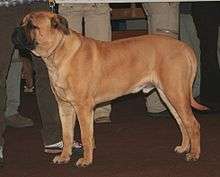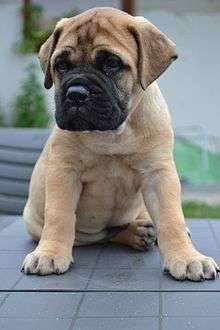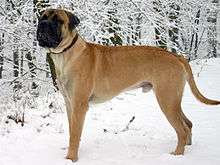Bullmastiff
The Bullmastiff is a large-sized breed of domestic dog, with a solid build and a short muzzle. The Bullmastiff is mastiff type dog, and was originally developed by 19th-century gamekeepers to guard estates. The breed was created by crossing the English Mastiff with the now extinct Old English Bulldog. It was recognized as a purebred dog by the English Kennel Club in 1924.[1]
| Bullmastiff | |||||||||||||||||||||||||||||
|---|---|---|---|---|---|---|---|---|---|---|---|---|---|---|---|---|---|---|---|---|---|---|---|---|---|---|---|---|---|
| Origin | United Kingdom | ||||||||||||||||||||||||||||
| |||||||||||||||||||||||||||||
| |||||||||||||||||||||||||||||
| Dog (domestic dog) | |||||||||||||||||||||||||||||
Appearance




.jpg)
Size
Bullmastiff males should stand 25–27 inches (64–69 cm) tall (American Kennel Club (AKC) standard) at the withers and weigh 110–130 pounds (50–59 kg). Females should be 24–26 inches (61–66 cm) at the withers, and 100–120 pounds (45–54 kg). Exceeding these dimensions is discouraged by breeders.[2]
Color
A Bullmastiff's coat may appear in fawn, red, or brindle. These are the only acceptable colours in the AKC standard.[3] The fawn can range from a very light brown to a reddish brown. Red can range from a light red-fawn to a dark, rich red. Brindles are a striped overlay of the fawn or red. A Bullmastiff should have no white markings, except for on the chest where a little white is allowed.
Head
The Bullmastiff is a brachycephalic breed. The term is describes a flat faced, shortened muzzled dog. The Bullmastiff head is not as extreme as some other breeds, such as the pug however, and it is not common for the Bullmastiff to have any breathing issues like some other flatter faced breeds. A black mask is required and is a hallmark of the breed.
History
Bullmastiffs are a large working breed originating in Britain in the mid-1800s as estate guardians to ward off poachers. They were bred by gamekeepers for strength, size and speed using a cross of the tough, heavy and aggressive Bulldog of the 19th century with the large, strong, less aggressive Mastiff.[4] As a result, the Bullmastiff is known as the Gamekeeper's Night Dog. The preferred color, by gamekeepers, was brindle, as this color works as a more effective camouflage, especially at night.[5]
The Bullmastiff breed was deemed pure by the English Kennel Club in 1924, with a genetic background of approximately 60% Mastiff and 40% Bulldog.[6] In 1934, the AKC recognized the Bullmastiff.[3] The first standard for the breed was approved in 1935.[7] The standard has undergone several revisions since then; the most current version is available on the AKC website.[8]
In 1928, the diamond mining company De Beers imported Bullmastiffs to South Africa to guard the mines.[9]
The Bullmastiff breed was bred to tackle and pin a poacher that comes on their land. An issue people have with the breed is that the dog may jump onto an unfamiliar person and tackle them until told to stop. This is why Bullmastiff owners must greet newcomers to the dog at their first interaction.
Trainability
Bullmastiffs are strong, powerful, but sensitive dogs. For a Bullmastiff to become a well-behaved family member, consistency is needed. Training and socialization is of high importance, as the breed can be independent.[3] Dogs of this breed are natural guardians of their home and owners. No special guard training is needed for a Bullmastiff to react appropriately if its family is endangered. Activities Bullmastiffs enjoy include obedience, agility, tracking, and carting.[1]
Health
A UK survey based on the lifespan of 96 Bullmastiffs found a median age of 7.5 years.[10] A Bullmastiff does not stop growing until their second birthday.
Health concerns within the breed include hip and elbow dysplasia, progressive retinal atrophy, bloat, and cancer, with a relatively high incidence of lymphoma and mast cell tumours.[11][12][13] Bullmastiffs are prone to certain hereditary diseases, including:
- Hip dysplasia, affecting 24.5% of individuals [14]
- Elbow dysplasia, affecting 13.8% of individuals,[15]
- Entropion, hypothyroidism affecting 2.8% of individuals,[16]
- Lymphoma
- Progressive retinal atrophy is a particular problem, since the trait is an autosomal dominant one. (This has recently been called into question by another medical team and has been proven that some Bullmastiffs have autosomal recessive PRA genes. In America, this is being investigated by the American Bullmastiff Health and Research Committee, and the DNA Optigen test only works for dominant genes, so it is considered inadequate at this time.)[17]
- Arthritis
- Gastric dilatation volvulus, also known as bloat.
Cosmetic genetic problems include longhairs and "Dudleys". Both are recessives and not common. The Dudley, named after a notable Bulldog breeder of the 19th century, the Earl of Dudley, is a lack of pigment in the mask. It can be liver colored or simply not present.
Famous Bullmastiffs
- Rocky – Roloff family dog (Little People, Big World)
- Swagger – the live mascot of the Cleveland Browns
- Butkus – pet of actor Sylvester Stallone and featured in the movie Rocky[18]
- Frank – 2007 film of the same name[19]
- Spot or Agent 11 – 2001 – from the film See Spot Run
- Pete in Homeward Bound II: Lost in San Francisco
- Pluto in 2015 Bollywood drama Dil Dhadakne Do[20]
See also
References
- Bullmastiff Page
- AKC standards
- "Get to Know the Bullmastiff", 'The American Kennel Club', Retrieved 29 May 2014
- Walkey B. The Bullmastiff Fancier's Manual. Sechelt B.C., Canada: Coast Arts Publishing; 1992
- "Bullmastiff". Animal Planet. Retrieved 12 March 2015.
- "Bullmastiff Breed Description: History and Overview". Minepuppy.com. 2018-02-24. Retrieved 2020-01-16.
- "1935 Bullmastiff standard" (PDF).
- American Kennel Club — Bullmastiff
- "Breed standard (Appendix A)" (PDF). Sabt.co.za. Archived from the original (PDF) on 2012-08-16. Retrieved 2012-09-18.
- "Individual Breed Results for Purebred Dog Health Survey". Retrieved 26 June 2012.
- Bell J, Cavanagh K, Tilley L, Smith FWK. Veterinary Medical Guide to Dog and Cat Breeds. Hoboken: Teton NewMedia; 2012.
- Edwards DS, Henley WE, Harding EF, Dobson JM, Wood JLN (2003). "Breed incidence of lymphoma in a UK population of insured dogs". Veterinary and comparative oncology. 1 (4): 200–6. doi:10.1111/j.1476-5810.2003.00025.x.CS1 maint: multiple names: authors list (link)
- Dobson JM (2013). "Breed-predisposition to cancer in pedigree dogs". ISRN Veterinary Science. 2013: 1–23. doi:10.1155/2013/941275.
- Orthopedic Foundation for Animals. "Hip Dysplasia Statistics". Archived from the original on 2010-10-19. Retrieved 2013-06-11.
- Orthopedic Foundation for Animals. "Elbow Dysplasia Statistics". Archived from the original on 2011-09-03. Retrieved 2013-06-11.
- Orthopedic Foundation for Animals. "Thyroid Statistics". Retrieved 2013-06-11.
- "PRA". Swedish Bullmastiff Club.
- Shepatin, Matthew (2009). "Then Madden Said to Summerall...": The Best NFL Stories Ever Told. Triumph Books. p. 134. ISBN 1617491985. Retrieved August 2, 2017.
- Frank (2007) on IMDb
- ""Didn't think twice before playing Pluto the dog: Aamir Khan". Indian Express. Retrieved June 8, 2015.
| Wikimedia Commons has media related to Bullmastiff. |
- Bullmastiff Details about Bullmastiff
- Bullmastiff at Curlie